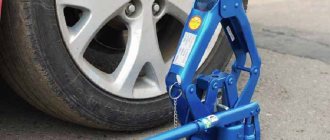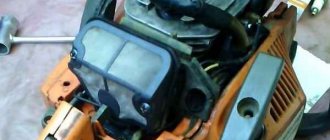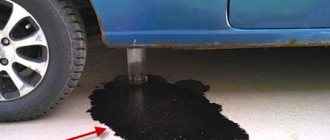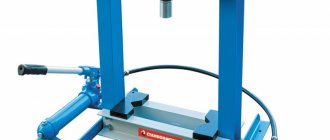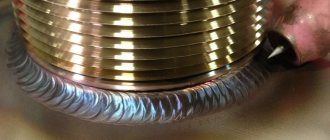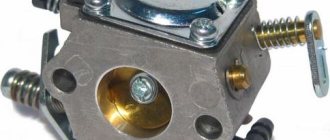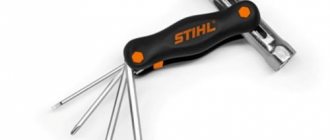Design and principle of operation of a rolling lift
The first step is to install it under the car; it is important that the supporting support is located in a certain place on the car. For this task, all cars have stiffening ribs; they are specifically designed to lift the car. Now you need to start pumping the handle up and down, so the bearing stop will rise.
The main element of the device is a hydraulic cylinder in which oil pressure is created, which is subsequently transmitted to the thrust part of the lift. A direct valve is also built into the design; if you turn the handle counterclockwise, the valve will open and the machine will lower.
Many motorists are interested in the question “does the rolling jack move when lifted?” Indeed, owners of this type of device are faced with a similar phenomenon. As it rises, the jack moves slightly under the car. This is not considered a problem, because this increases the stability of the structure.
Common faults
Failures during operation are typical for any device, even with an increased safety margin. One of the most common malfunctions is when the rolling jack does not hold the load or oil leaks. In the latter case, you will have to disassemble the tool to carry out repair work, and this will be a little more difficult. Now we will take a closer look at each problem in detail and provide solutions.
The rolling jack does not lift
The problem is that the thrust part comes out very slowly or the rolling jack has stopped lifting completely. And the reasons may be the following: airing of the system due to a decrease in oil level or wear of the seals. The last option can be eliminated quite simply; you just need to disassemble the device, replace the deformed gaskets, and then put it back together. Then all that remains is to fill in the hydraulic oil. Removing air from their system will take you even less time. Perform all steps in this order:
- First, unscrew the shut-off valve 1 turn from the closed position.
- Now the jack handle should be lowered to the minimum position.
- Unscrew the filler plug and then remove the rubber plug.
- Drain the old oil from the system, fill it with kerosene, and pump the jack well, that is, raise and lower the jack several times. Then the dirty kerosene needs to be drained; we recommend repeating the procedure of pouring clean kerosene. You can skip this step if you have been using the jack for less than 1 year.
- Fill the jack with new oil, you can use any car oil, just make sure it is not too thick.
- After refueling, it is worth pumping the system a couple of times, then excess air bubbles will come out.
The whole procedure will take you no more than 25 minutes, but you will be able to restore the functionality of your lift.
The jack doesn't hold
If you find that the rolling jack does not hold under load, there may be two reasons. The most common is that the drain valve is clogged or broken. If your jack has been in use for about 2 years, then it is not at all surprising that it has stopped holding. Dirt simply gets clogged into the valve and it stops pressing tightly. In this case, it is enough just to flush the system with gasoline or kerosene, and then fill in new oil. But in other situations, such a simple repair cannot be done.
If you have completely disassembled the jack and found serious damage to the valve balls, they need to be replaced. To do this, you need to order a repair kit for your jack; it is better to do this through online stores. The repair kit usually includes springs and balls. It is better to replace all the parts at once, then you will not have to face new difficulties in the future.
The rolling jack is lowering
Flowing
If you have a situation where the rolling jack is leaking, then you need to start repairs immediately. After all, if you delay in this matter, the situation may worsen. For example, when oil leaks out, air gets in, which can cause the main piston to begin to oxidize. In the future, this may cause the hydraulic lift to jam, in which case it will be much more difficult to repair. If you notice a leak in the jack, you can restore it as follows:
- Disassemble the tool to get to the leak. At this stage, it is also necessary to prepare a container into which the oil from the system should be drained in advance.
- Remove the piston and inspect it carefully. There should be no signs of corrosion on it. If there are pockets of rust, you can use a clean cotton cloth and GOI paste for mirror polishing. Dampen a rag with kerosene and then apply a thin layer of paste to it. After which you need to rub the piston for a long time, after which the traces of rust will disappear.
- Inspect the rod; if it is deformed, then you don’t even have to try to fix anything. After all, it is simply impossible to straighten it back, because it is made of durable hardened steel. The repair can be completed at this point; it can be continued only when you find exactly the same rod.
- Replace all sealing elements and cuffs with new ones and reassemble the tool.
- Then you can add fresh oil, and be sure to bleed the hydraulic system with the filler plug open.
How to extend service life
- If you do not use the jack for a long time, it is recommended to periodically bleed the hydraulic system (at least once every 3 months). In this case, you will prevent the formation of corrosion and jamming of the piston.
- Remember to lubricate the rod with a light grease. This way you will significantly extend the life of the tool. It is also necessary to wipe the jack from dirt and dust, and inspect all parts (especially for oil leaks).
- If you do not plan to use a jack, the support part should remain completely lowered. Otherwise, over time it may begin to rust.
- Add hydraulic oil occasionally. Manufacturers do not recommend mixing oils of different brands.
- Once every 2 years, you need to completely flush the hydraulic system from dirt and small particles. It is also recommended to change the O-rings and cuffs.
- If you do not use the jack, you should store it in a dry place at above-zero temperatures.
Source
How to bleed a hydraulic (bottle) jack since it has stopped lifting and is springing?
I have a hydraulic (bottle) jack from Kuvalda 5 tons, all the liquid was accidentally drained from it. Is the fluid suitable for power steering and should I bleed it at all? Maybe someone can tell me?
- Steering wheel vibration when braking! SOSSSSSSSSSSSSS
- selection of brake discs
- chassis Volkswagen Passat (B3/B4)
- When it's hot, it won't start until you press the gas to the floor, and then you have to turn it for a long time?
- Autotest
- Do you want clear headlight reflectors?
A spindle (spindle hydraulic AU) is poured into hydraulic jacks, so it prevents the formation of an emulsion, protects equipment from wear and corrosion, and has high performance properties.
Look at how a guy repairs a hydraulic jack, everything is very accessible and detailed. And that’s for sure about the spindle, power steering fluid is not suitable, IMHO.
Before pumping: 1. you need to check the valve; to do this, unscrew the valve and check for deformation or dirt getting inside the valve; if the valve is in a faulty state due to mechanical deformation, then it simply needs to be replaced; 2. you need to drain the oil completely; 3. all parts must be washed to remove dirt and oil; 4. Open the oil tank cap and the bypass valve, and then quickly pump the hydraulic press pump several times.
You need to pump it like this, there is a hole on the side of the jack, through it you fill in spindle oil or any hydraulic fluid (not important), then push the piston out all the way using the hydraulics, put the jack on its side with the filling hole up and press in the piston - this should force the air out of the hydraulic cylinder, then, if necessary, add oil and, if necessary, repeat the operation a couple of times.
Repair of rolling jack
Without a jack, a car enthusiast, without exaggeration, is left “without hands.” And you need it not only to change a tire on the road. A good jack is indispensable for some types of repair work - especially in an ordinary garage that is not equipped with a lift. For example, when assembling the suspension after repair, when it is necessary to make the final tightening of the levers.
There is absolutely no need to lower the car onto the wheels so that the silent blocks take the “working” position - just jack up the lever to give it the desired position.
A rolling hydraulic jack is especially convenient - thanks to its design, it can be installed under a part located low - so that no other jack can get under it.
The jack does not lift under load
Sometimes problems arise with hydraulic jacks. Most people throw them away immediately. But don’t throw it away, maybe the problem isn’t that big.
But it happens that the jack does not raise it to the required height. Previously, for example, the length of the rod was enough to lift the car, but now it is not. It rises halfway and that’s it. Oil is to blame here. More precisely, its lack.
When a working jack works, oil is still consumed. Quite a bit, but it is used up with each rise/fall. For good reason, it should be changed from time to time - about once a year. But who does this kind of nonsense here?) Usually it works as long as it works)
In general, two of my jacks malfunctioned. One is rolling, the other is bottle-type, both are hydraulic, of course. A rolling jack is the same as a bottle jack, only installed in a special design. After I raised the car, they slowly lowered it. I decided to add oil.
In general, it is recommended to add special hydraulic oils to such jacks. You can go and buy it, you can fill it with spindle oil, which is also hydraulic. Or you can, at your own peril and risk, top up with regular engine fuel. Which is what I did. This, of course, is not recommended, the properties of the oil are not the same, but oh well
.
First you need to lower the jack completely. We unscrew the fitting, lower the rod (or the lifting part of the rolling part), and screw the fitting back. We find the hole through which the oil is poured. It is closed with a rubber plug.
Reading time: 5 minutes
There are many types of lifting mechanisms, the most common among car enthusiasts is the hydraulic type of jacks (bottle, rolling). If improperly maintained, jacks can fail, for example, they stop lifting loads. And the question immediately arises of what to do if the hydraulic jack does not lift. You don’t have to buy a new one right away; there is always a way out; often everything can be fixed by performing maintenance on the unit.
How to fill oil correctly
It is the lack of oil in the jack that leads to its poor performance. Fortunately, such a breakdown is easy to fix - you just need to add liquid. However, you should know what exactly to add.
The working fluid in a jack is often called oil. This is because it is what is used in jacks, although the device will work even on water.
High-quality fluid will ensure long-term operation of the mechanism:
- Industrial types of industrial oil. But not types I30A, I40A, I50A - they are too viscous.
- Brake fluid is excessively hygroscopic, that is, it absorbs water vapor. And water will eventually lead to corrosion and failure.
- Branded hydraulic fluids are manufactured specifically for brake and lifting systems.
- The water jack won't last long, but it will work.
Important!
You should also avoid liquids of glycol, petroleum and mineral origin. The best solution is synthetic oil, which also does not thicken in the cold.
After the fluid has been selected, it is necessary to carry out preparatory work to replace it.
You may be interested in this Features and advantages of a vulcanizer for repairing truck tires
First, the old fluid is drained. To do this, unscrew the plug and pump the device. Next, the jack is washed with cleaning fluid, which can be purchased at a hardware store. The solution is poured and drained. Before adding new oil, there should be no foreign liquid in the jack.
How to unscrew the plug
Afterwards, the jack is set to the lowest position, and the screw-cock is turned to the “Drain” position. Oil is poured. The required level is indicated by a mark on the jack.
Important!
The oil level must be as accurate as possible. You can’t either overfill or underfill.
After the first filling, the plug is closed and the jack is run 5-6 times. The plug is opened again and oil is poured in. It is necessary to repeat several times until the oil stops leaving.
After the final filling of the oil, a test distillation of the liquid is performed again to get rid of air. To do this, the jack is pumped - raised and lowered - until pressure appears. Excess air is released through special tubes; oil must be added in its place as it exits.
The jack does not lift under load, what should I do?
Man has invented many devices for lifting weights. To briefly describe the principle of their operation - the transformation of the distance traveled into effort.
Let's look at examples of such transformations:
- Lever arm. On the long side, the distance traveled is greater and the effort is less. On the short side it's the opposite;
- Block system. The cable, passing through a certain number of blocks, loses distance with each loop, proportionally acquiring additional traction force;
- Gears with different gear ratios. The small gear rotates quickly and with less force. Big – on the contrary;
- Chain (belt) pair. A smaller diameter pulley rotates effortlessly and faster. A larger diameter pulley develops high torque on the shaft at a lower rotation speed;
- Communicating vessels. Two piston pairs connected to each other operate on the principle of a lever. A piston of a smaller diameter moves with a small force with a large swing. While its larger “brother” moves a short distance with proportionally increased effort.
A hydraulic jack operates on the principle of communicating vessels.
Relatively compact dimensions (compared to the force that the tool can develop) make it indispensable when working with large weights. Portable bottle jacks (this is their second name) develop a force from 1 to 20 tons. Larger specimens can weigh up to 200 tons.
At the same time, hydraulics are among the safest devices for lifting heavy objects.
Design, features of using a bottle jack
The illustration shows what components a hydraulic lift consists of.
The entire structure fits inside a reservoir with working fluid. The lifting rod in the lower position is completely recessed into the housing. The lever handle is removable and does not take up much space in the transport position. Therefore, jacks of this type easily fit in the trunk of a car.
The device, capable of lifting a solid SUV (force 5 tons), has dimensions (taking into account the detached handle) no larger than a 0.7 liter bottle of wine. One person can handle such a jack.
- Easy to operate and maintain;
- High efficiency – up to 80%;
- Low force on the working handle;
- Smooth operation due to the use of liquid;
- Ability to control lift height with high accuracy;
- High reliability due to the absence of rotating and rubbing parts;
- Long service life - other than the O-rings, there is nothing to wear out in the bottle jack;
- A good indicator of safety in operation - in the event of a breakdown, a sharp fall of the lifted object or a part of the tool being thrown to the side is excluded;
- Wide range of application possibilities, not limited to use only in cars.
- The height of the jack body is almost equal to the lifting height. This is typical for single-rod designs; telescopic (multi-rod) options do not have this drawback. This feature is partially compensated by a screw that unscrews from the rod - an extension. Due to this disadvantage, the initial lifting height starts from 20-25 cm. This limits the dimensions of the device;
- Slowness. One cycle of operation of the injection pump provides lifting to a low height. The higher the load capacity, the more movements the handle must be made to lift;
- Inability to accurately control the height of the load;
- Work only in a vertical position. In an inclined or horizontal state, air will enter the hydraulic system and it will have to be pumped;
- Large mass of the device, taking into account the working fluid;
- High cost of the product.
To work with low initial heights (for example, low-slung passenger cars), a rolling jack is used. It operates on a lever circuit, and a hydraulic cylinder is used as the driving force, as in a conventional bottle jack.
DIY hydraulic jack maintenance and repair
To know how to repair this device, you need to study its structure and operating principle. The cross-sectional diagram is shown in the figure:
The working cylinder (4) is tightly screwed into the powerful base (10).
The connection must be reliable, since the pressure of the working fluid (6) when lifting heavy objects is quite high.
A working piston (5) with a sealing ring is placed in the cylinder. An extension screw (3) is screwed into the working piston (also known as the lifting rod), which, if necessary, is unscrewed by 2/3 of the length of the rod.
What types of breakdowns happen and what causes them?
Hydraulic jacks are the most durable. Their malfunction may be caused by improper operation or wear of individual parts. A common problem is lifting weights that exceed the unit's capabilities. Then you can observe the following “symptoms”:
| What is observed | Where is the breakdown? | Why did it break? | What to do |
| Stop | In a cylinder | Not enough oil, filters may become clogged | Disassemble the device. Fill the oil compartments, clean the filters |
| Piston does not rise | In a cylinder | Lack of pressure due to lack of sufficient working fluid | Add liquid |
| The rise is very slow or, conversely, jerky | In a cylinder, system with working fluid | Air has entered the jack, which negatively affects the operation of the piston. | It is necessary to add liquid and remove air through the tubes |
| Low pressure | Valves | The springs are weakened. The valves are moving away from the compartments. The valves are dirty. | Replacing valve or spring Repair or clean if possible |
Note!
Mechanical damage to the jacks, both the body and the piston, is not considered. In the event of such a breakdown, repairing the jacks will be impractical - it is better to buy a new device.
In other cases, it is necessary to disassemble the mechanism and put it back together so that the following conditions are met:
- The valves fit tightly.
- Sufficient amount of working fluid in the departments.
- There is no air in the system.
They are applicable for all models of devices, including for repairing a 5-ton jack manufactured in the USSR.
Repair in Moscow: what to do if the hydraulic jack does not lift
The hydraulic jack is the most common and useful lifting device in the world, and problems with a hydraulic jack can be an unpleasant surprise.
The areas of its use are so diverse that it is not possible to mention all of them. This is due to the fact that the methods and purposes of its use are limited only by your ingenuity and imagination. Hydraulic jacks are mainly used in the following areas:
For lifting and lowering cars, trucks, and special equipment. Almost every car owner has a hydraulic jack with a lifting capacity of 2 - 3 tons. All car service centers keep rolling hydraulic jacks in their arsenal. This simple mechanism will easily lift your car.
During construction work. You need to raise some structure or building - please. It is only necessary to take into account the maximum lifting capacity of the jack, which should not be less than the load being lifted. So why won't the hydraulic jack hold?
Repair of a 3t hydraulic jack in the event of a malfunction, why does the hydraulic jack not hold? How to restore a hydraulic jack?
The hydraulic jack does not work reasons:
It often happens that the hydraulic jack does not lift and it is not clear what to do. If the hydraulic jack does not work, what could be the reasons? Let's try to figure out this situation.
Hydraulic lifting devices periodically require maintenance, which is why it is necessary to add oil to the working cylinder, which leaks out through various seals and oil seals during operation.
Some signs of a faulty hydraulic jack:
- The jack raises the load to the required height, the load is not able to hold it, a gradual spontaneous lowering occurs
Reason: malfunction of the jack bypass valve or failure of the cuffs. Because of this, the required pressure is not maintained.
- The hydraulic jack fails to lift the load or only lifts it to a small height, i.e. There is a decrease in the working stroke, the reason why the hydraulic jack does not work.
The cause of the malfunction of the hydraulic jack is the appearance of corrosion on the rod and on the inside of the cylinder body. And if a jack was used to lift a load that exceeded the maximum permissible weight for this device, the rod may have become bent.
- The jack does not return completely to its original position after opening the release valve.
The cause of the hydraulic jack malfunction: springs that are stretched or have lost their elasticity.
The hydraulic jack does not lift - the main causes of hydraulic jack malfunctions and how to eliminate them:
One of the most common causes of jack failure, if the rolling hydraulic jack does not work, can be oil leakage. As a result, air gets into the working chamber, as a result, the lifting mechanism does not work at full strength or stops functioning, this is the answer to the question why the hydraulic jack does not hold.
This problem can be avoided by periodically performing maintenance on the hydraulic jack, which consists of monitoring the amount of fluid and, if necessary, adding it to the working cylinder. A decrease in the amount of oil in the system can be a consequence of natural operational loss, as well as due to damaged or faulty oil seals and seals. In this case, simply adding fluid will not solve the problem; it will be necessary to replace the failed seals and seals.
Due to the lack of working fluid in the system, air takes its place - this can be guessed by the reduced efficiency of the jack. You can get rid of this problem by pumping. But if this does not help, then either the cause of the malfunction is different, or more serious repairs will be required.
Often, the cause of incorrect operation of a hydraulic jack can be corrosion that affects the retractable pistons (rods or plungers) and the inside of the housing. But to find out the reason, you will need to disassemble the device. To do this, you can contact service workshops.
A bent rod also often causes the jack to fail; in this case, if provided for by the design features of the model, it can be replaced with a new one, and often this means that the jack cannot be repaired even in a service workshop.
Sometimes dirt gets into the working chamber, which can also cause the jack to fail. The hydraulic jack won't lift, what should I do? Why is the hydraulic jack not working?
How to restore a hydraulic jack if the hydraulic jack does not hold for a reason or the hydraulic jack does not work for a reason?
How to restore a hydraulic jack? This can be done as follows: you can remove dirt by washing it with kerosene. The jack bypass valve can also be the culprit quite often. The jack bypass valve may have some deformation or dirt may have gotten into it, causing the ball to not sit tightly in the seat and hence fluid leaking out. This problem is solved mainly radically - the jack bypass valve is replaced with a new one.
Jack operating diagram
Diagram of operation of a hydraulic jack
Professional rolling jacks differ in size and load capacity. As a rule, the valve is controlled by turning the handle, which is very convenient during operation. But the principle of operation of all hydraulic jacks is the same, so it is more convenient to use the diagram - after all, despite the size and type of products, they have the same causes of breakdowns.
Rolling jacks differ in size and load capacity. Typically, the valve is controlled by turning the handle.
The force created by the plunger is transmitted through the oil used as the working fluid to the piston connected to the rod. In this case, oil is pumped from the front cavity of the jack cylinder to the rear cavity (from the plunger side). The bypass channel is closed, and the inlet and discharge valves allow the oil to move only towards the rear cavity, that is, the jack works like a pump. When the bypass needle (which is a pointed threaded rod) is opened, oil can flow back into the front cavity through the bypass channel. If at this moment the jack is under load, the piston rod will sink into the cylinder. The performance of the jack is ensured by compliance with three conditions:
- Tight fit of valves to seats.
- Required oil level.
- No air bubbles in the oil.



